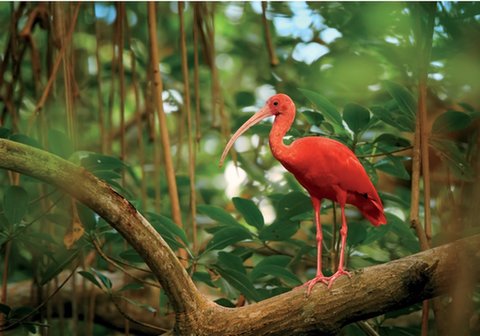North
America
South
America
Pacific
Ocean
Brazil
Iworkinaplacewherelandandoceanwatermeet.Itisamangroveforest.Mangrovesareagroupofdistinctivetreesthatrisefromatangleofrootslodgedinthemud.Thesewetlandsare tough.
Mangroveshrubsandtreesliveinwaterupto100timessaltierthanmostotherplantscantolerate.Theythrivedespitetwice‑dailyfloodingbyoceantides.Andtheyfrequentlybearthebruntofoceanstormsand hurricanes.
WelcometoBrazil
OnthecoastofBrazilliethelongestcontinuousmangroveforests.Theseareamongthemostunspoiledmangroveforests.Treesherearemorethan40 meters(131feet)highandcanstoretwiceasmuchcarboninthesoilthanthenearbyAmazon rainforest.

Ascarletibisfindsahomeinthe mangrove.

Shipwormsnibbleawayatdead wood.
Mangrovesteemwithlife.Crabs,fishes,birds,andinsectsfindfoodandhomeshere.Oneofthemoststrikingmangrovebirdsisthescarlet ibis.
You’llalsofindshipwormshere.Theyaren’tasattractiveastheibis,buttheyareincrediblyimportantbecausetheyeatdeadwoodonmangrovetrees.Thencrabsandfisheseattheworms.Thishelpstransfernutrientsfromonelivingthingtoanotherandkeepsthemangroveshealthy.Forthepeoplewholivehere,thesewetlandsarecriticalforthefisheries,timber,andother materials.
ThePowerofMangroves
Asclimatechangeincreases,weseeclearlyhowmangrovesalsoprotectusfromnaturalhazards,suchasstorms.Mangrovesformalivingbarrierthatshelterspeopleand wildlife.
Sealevelsarerising.Stormsaregettingstrongerandmoredamagingtocoasts.Mangrovesabsorbtheshockofthestorms.Theyreducetheimpactofthewavesandhigh winds.
Mangrovesalsotrapcarbon.Thedenserootsofmangroveshelptobindandbuildsoil.Theabovegroundrootsslowdownwaterflows,whichreduceserosion.Likemostwetlands,mangrovessufferfromhumandevelopment.Wemustlearntoprotectmangrovesinreturnforthemprotecting us.

Iclimbedintotherootsofthistreetogetabetterlookatthewhole mangrove.